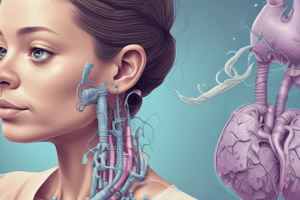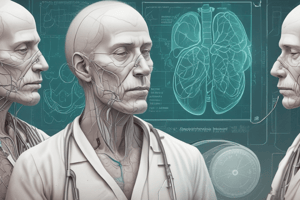Podcast
Questions and Answers
What is the primary purpose of oxygen therapy?
What is the primary purpose of oxygen therapy?
- To reduce air pollution
- To enhance physical endurance
- To increase oxygen saturation in tissues (correct)
- To treat viral infections
Oxygen therapy is only used for patients with chronic lung diseases.
Oxygen therapy is only used for patients with chronic lung diseases.
False (B)
What color is oxygen gas?
What color is oxygen gas?
Colorless
Oxygen therapy is administered at a concentration greater than that found in the __________ atmosphere.
Oxygen therapy is administered at a concentration greater than that found in the __________ atmosphere.
Match the following oxygen delivery systems with their classification:
Match the following oxygen delivery systems with their classification:
What complication can occur with prolonged exposure to high concentrations of oxygen?
What complication can occur with prolonged exposure to high concentrations of oxygen?
The air we breathe contains approximately 21% oxygen.
The air we breathe contains approximately 21% oxygen.
Name one condition that oxygen therapy can help treat.
Name one condition that oxygen therapy can help treat.
The __________ mask provides the highest concentration of oxygen in low flow systems.
The __________ mask provides the highest concentration of oxygen in low flow systems.
Which oxygen delivery system delivers a specific and constant percent of oxygen regardless of the client's breathing?
Which oxygen delivery system delivers a specific and constant percent of oxygen regardless of the client's breathing?
What is the maximum flow rate for a nasal cannula?
What is the maximum flow rate for a nasal cannula?
The non-rebreather mask allows for the conservation of exhaled air.
The non-rebreather mask allows for the conservation of exhaled air.
What oxygen concentration does a partial rebreather mask deliver?
What oxygen concentration does a partial rebreather mask deliver?
The simple oxygen mask delivers between ___ and ___ percent oxygen.
The simple oxygen mask delivers between ___ and ___ percent oxygen.
Match the following oxygen delivery methods with their characteristics:
Match the following oxygen delivery methods with their characteristics:
What is a significant disadvantage of using a nasal cannula?
What is a significant disadvantage of using a nasal cannula?
The flow rate for a simple oxygen mask is between 6 to 10 liters per minute.
The flow rate for a simple oxygen mask is between 6 to 10 liters per minute.
What must remain inflated during both inspiration and expiration when using a partial rebreather mask?
What must remain inflated during both inspiration and expiration when using a partial rebreather mask?
The oxygen flow rate for a non-rebreather mask must be between ___ and ___ liters per minute.
The oxygen flow rate for a non-rebreather mask must be between ___ and ___ liters per minute.
What is the primary advantage of using a nasal cannula?
What is the primary advantage of using a nasal cannula?
What is the flow rate for a Venturi mask?
What is the flow rate for a Venturi mask?
Oxygen therapy can cause absorption atelectasis.
Oxygen therapy can cause absorption atelectasis.
What is a sign of oxygen toxicity?
What is a sign of oxygen toxicity?
A nasal cannula can deliver oxygen at a flow rate of __________ L/min.
A nasal cannula can deliver oxygen at a flow rate of __________ L/min.
Match the oxygen delivery devices with their corresponding flow rates:
Match the oxygen delivery devices with their corresponding flow rates:
What is the maximum oxygen concentration provided by a reservoir mask?
What is the maximum oxygen concentration provided by a reservoir mask?
Oxygen concentration greater than 50% is safe for longer than 48 hours.
Oxygen concentration greater than 50% is safe for longer than 48 hours.
What device is used on the end of an ET tube when weaning from a ventilator?
What device is used on the end of an ET tube when weaning from a ventilator?
The oxygen delivery device that requires a minimum flow of 5 L/min is the __________.
The oxygen delivery device that requires a minimum flow of 5 L/min is the __________.
Which of the following is NOT a sign of oxygen toxicity?
Which of the following is NOT a sign of oxygen toxicity?
Flashcards
What is oxygen therapy?
What is oxygen therapy?
Oxygen therapy is the administration of oxygen at a higher concentration than what is found in the air we breathe.
Why is oxygen therapy used?
Why is oxygen therapy used?
Oxygen therapy is used to increase oxygen levels in the blood when they are too low due to illness or injury.
What is oxygen?
What is oxygen?
Oxygen is a colorless, odorless, and tasteless gas that is essential for human life.
What is a nasal cannula?
What is a nasal cannula?
Signup and view all the flashcards
What is a simple mask?
What is a simple mask?
Signup and view all the flashcards
What is a non-rebreather mask?
What is a non-rebreather mask?
Signup and view all the flashcards
What is a Venturi mask?
What is a Venturi mask?
Signup and view all the flashcards
What is oxygen toxicity?
What is oxygen toxicity?
Signup and view all the flashcards
Are there any fire hazards associated with oxygen therapy?
Are there any fire hazards associated with oxygen therapy?
Signup and view all the flashcards
Can oxygen therapy increase the risk of infection?
Can oxygen therapy increase the risk of infection?
Signup and view all the flashcards
Nasal Cannula
Nasal Cannula
Signup and view all the flashcards
Simple Oxygen Mask
Simple Oxygen Mask
Signup and view all the flashcards
Partial Rebreather Mask
Partial Rebreather Mask
Signup and view all the flashcards
Non Rebreather Mask
Non Rebreather Mask
Signup and view all the flashcards
Venturi Mask
Venturi Mask
Signup and view all the flashcards
Fraction of Inspired Oxygen (FIO2)
Fraction of Inspired Oxygen (FIO2)
Signup and view all the flashcards
Low-Flow Oxygen Delivery
Low-Flow Oxygen Delivery
Signup and view all the flashcards
High-Flow Oxygen Delivery
High-Flow Oxygen Delivery
Signup and view all the flashcards
What is a T-Piece?
What is a T-Piece?
Signup and view all the flashcards
What is Absorption Atelectasis?
What is Absorption Atelectasis?
Signup and view all the flashcards
What is Retrolental Fibroplasia?
What is Retrolental Fibroplasia?
Signup and view all the flashcards
What is FIO2?
What is FIO2?
Signup and view all the flashcards
What is High Flow Oxygen Therapy?
What is High Flow Oxygen Therapy?
Signup and view all the flashcards
What is Oxygen Saturation?
What is Oxygen Saturation?
Signup and view all the flashcards
What are Vital Signs in Oxygen Therapy?
What are Vital Signs in Oxygen Therapy?
Signup and view all the flashcards
Study Notes
Oxygen Therapy Overview
- Oxygen therapy is the administration of oxygen at a concentration higher than ambient air (approximately 21% oxygen)
- It's crucial for various conditions where the body's oxygen levels are too low.
- Oxygen is a colorless, odorless, and tasteless gas essential for proper bodily functions and survival.
Learning Objectives
- Define oxygen therapy and its purpose.
- Identify different types of oxygen therapy.
- Outline procedures for administering oxygen therapy.
- Note potential complications of oxygen therapy.
Purposes of Oxygen Therapy
- Increase oxygen saturation in tissues when levels are below normal, due to illness or injury.
- Used to treat conditions like documented hypoxemia, severe respiratory distress (e.g., asthma, pneumonia), severe trauma, and chronic obstructive pulmonary disease (COPD), including chronic bronchitis, emphysema, and chronic asthma
- Treat pulmonary hypertension and acute myocardial infarction (heart attack).
- Often used as short-term therapy, such as post-anesthesia recovery.
- Used for treating chronic lung disease patients during exercise.
Methods of Oxygen Administration
- Low Flow Systems: These systems deliver oxygen that contributes partially to the inspired gas the patient breathes, the amount is dependent on the client's breathing. Examples include Nasal Cannula, Simple Masks, Partial Rebreathers, Non-rebreathers
- High Flow Systems: These systems deliver specific and constant oxygen percentages,independent of the client's breathing. Examples include Venturi Masks, Trach Collar, T-piece.
Oxygen Delivery Devices
- Nasal Cannula: A disposable plastic device with prongs inserted into the nostrils. Used for low to medium oxygen concentrations (24-44%).
- Simple Oxygen Mask: A clear, flexible plastic or rubber mask molded to the face. Delivers 35-60% oxygen at 6-10 liters per minute. Suitable for short-term use.
- Partial Rebreather Mask: Delivers oxygen concentrations up to 80% with a reservoir bag preventing the re-breathing of exhaled air. A minimum flow rate of 6 L/min is needed to maintain reservoir inflation.
- Non-Rebreather Mask: Provides the highest oxygen concentrations (95-100%) at 6-15 Liters per minute. A reservoir bag is used, and one-way valves prevent re-breathing exhaled air.
- Venturi Mask: Delivers specific and constant oxygen concentrations (40-50%) at 4-15 Liters per minute using a Venturi device. The specific oxygen concentration is determined by color-coded valves.
- T-piece: Used during ventilator weaning, providing accurate oxygen delivery and humidity to the patient.
Cautions and Complications
- Oxygen Toxicity: Can occur with inspired oxygen fractions (FIO2) greater than 50% for more than 48 hours.
- Infection: A possible complication that needs to be considered.
- Fire Hazard: Oxygen is a strong oxidizer.
Evaluation
- Assess the patient's breathing pattern, color of nail beds, lips, conjunctiva.
- Check for confusion, disorientation, cognition difficulties.
- Evaluate arterial oxygen concentration/hemoglobin.
- Monitor oxygen saturation with appropriate devices and methods.
Documentation
- Record the timing of oxygen therapy initiation.
- Document the method of delivery.
- Note oxygen concentrations and flow rates.
- Include patient observations.
- Add oronasal care instructions to the patient plan for care.
Equipment Specifications
- A table detailing oxygen delivery devices, flow rates, FIO2 (fraction of inspired oxygen), and special notes is included in a separate section for reference.
Studying That Suits You
Use AI to generate personalized quizzes and flashcards to suit your learning preferences.




